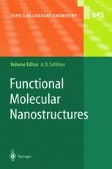Search
Search Results
-
Carbene Complexes of Heme Proteins and Iron Porphyrin Models
The possible formation of carbene complexes of cytochromes P450 enzymes in various metabolisms of xenobiotics is first described. In view of these...
-
Ferrocene–Peptide Bioconjugates
This chapter sketches an outline of ferrocene–peptide bioconjugates. A variety of ferrocene–peptide bioconjugates have been designed to induce...
-
Catalytic Nickel–Iron–Sulfur Clusters: From Minerals to Enzymes
The geochemical theory of the origin of life proposes that primordial, pre-biotic reactions were carried out in a metal-sulfide-rich environment...
-
Sequentially Palladium-Catalyzed Processes
Sequentially palladium-catalyzed reactions consist of combinations of identical, related, or significantly different palladium-catalyzed processes...
-
Arylation Reactions via C-H Bond Cleavage
Various carbon nucleophiles having acidic C–H bonds, including active methylene compounds, ketones, aldehydes, esters, and so on, are arylated with...
-
Chiral Diaminocarbene Complexes, Synthesis and Application in Asymmetric Catalysis
The synthetic routes to optically pure N-heterocyclic carbene (NHC) complexes and their application in asymmetric catalysis is reviewed. Chiral...
-
Non-covalent Immobilization of Catalysts Based on Chiral Diazaligands
The immobilization of chiral catalysts through non-covalent methods, as opposed to covalent immobilization, allows an easier preparation of chiral...
-
Oxide- and Zeolite-supported “Molecular” Metal Clusters: Synthesis, Structure, Bonding, and Catalytic Properties
This review is a summary of supported metal clusters with nearly molecular properties. These clusters are formed by adsorption or surface-mediated...
-
Electrochemistry and Electrogenerated Chemiluminescence of Semiconductor Nanocrystals in Solutions and in Films
A retrospective overview of electrochemical studies of semiconductor nanocrystals (NCs) is given. The electrochemical behavior of monodisperse NCs...
-
Spectroscopic Characterization of Organometallic Centers on Insulator Single Crystal Surfaces:From Metal Carbonyls to Ziegler--Natta Catalysts
A detailed knowledge of the microscopic properties is one of the prerequisites for an understanding of heterogeneous catalysts. A strategy which...
-
Electrophoretic mobility of colloidal particles in salt-free media
It is shown that the electrophoretic mobility μ of dilute spherical colloidal particles of radius a, carrying charge Q in a salt-free medium...
-
Equilibrium Structure of Dendrimers – Results and Open Questions
We review the problem of the structure of dendrimers in solution. Special emphasis is placed on recent theoretical work and computer simulations of...
-
Discrete Organic Nanotubes Based on a Combination of Covalent and Non-Covalent Approaches
Tubular organic nanostructures offering precise control over inner and outer surface functionality represent attractive building blocks for the...
-
Palladium-Catalyzed Cross-Coupling Reactions of Unactivated Alkyl Electrophiles with Organometallic Compounds
For many years, unactivated alkyl electrophiles that contain β hydrogens were generally regarded as unsuitable partners for palladium-catalyzed...
-
A Covalent Chemistry Approach to Giant Macromolecules with Cylindrical Shape and an Engineerable Interior and Surface
This article divides the synthetic routes leading to dendronized polymers into two main categories (attach-to and macromonomer) and compares their...
-
Asymmetric Processes Catalyzed by Chiral (Salen)Metal Complexes
A wide variety of highly selective asymmetric reactions catalyzed by chiral (salen)metal complexes have been disclosed over the past decade. Salen...
-
Use of N,N-Coordinating Ligands in Catalytic Asymmetric C--C Bond Formations: Example of Cyclopropanation, Diels--Alder Reaction, Nucleophilic Allylic Substitution
Chiral N,N-coordinating ligands have been particularly synthesized for their use as metal chelates catalyzing asymmetric C-C bond formations....
-
Progress in the Asymmetric Synthesis of 1,2-Diamines from Azomethine Compounds
Recent advances in the preparation of optically pure 1,2-diamines by stereoselective addition reactions to azomethine compounds (imines, iminium...
-
Sparteine as a Chiral Ligand for Asymmetric Catalysis
While the use of stoichiometric amounts of sparteine and related ligands in various asymmetric reactions often lead to highly enantioselective...
-
The Zintl–Klemm Concept Applied to Cations in Oxides. II. The Structures of Silicates
The structures of ternary and quaternary silicates are revisited on the basis of the Zintl–Klemm concept and the Pearson's generalised octet rule....
